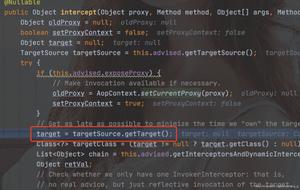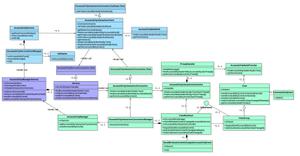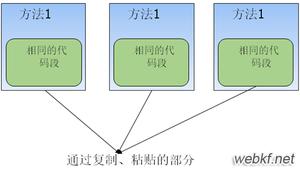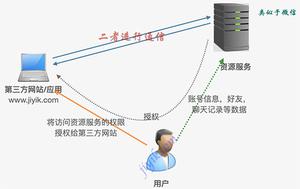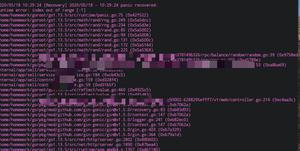spring5 源码深度解析----- IOC 之 容器的基本实现
本文内容纲要:
- 概述- 容器的基本用法
- 功能分析
- 工程搭建
- beans包的层级结构
- 核心类介绍
- 容器的基础XmlBeanFactory
- 配置文件的封装
- bean加载
- 获取XML的验证模式
- 获取Document
- 解析及注册BeanDefinitions
概述
上一篇我们搭建完Spring源码阅读环境,spring源码深度解析—Spring的整体架构和环境搭建 这篇我们开始真正的阅读Spring的源码,分析spring的源码之前我们先来简单回顾下spring核心功能的简单使用
容器的基本用法
bean是spring最核心的东西,spring就像是一个大水桶,而bean就是水桶中的水,水桶脱离了水也就没有什么用处了,我们简单看下bean的定义,代码如下:
package com.chenhao.spring;/**
* @author: ChenHao
* @Description:
* @Date: Created in 10:35 2019/6/19
* @Modified by:
*/
public class MyTestBean {
private String name = "ChenHao";
public String getName() {
return name;
}
public void setName(String name) {
this.name = name;
}
}
源码很简单,bean没有特别之处,spring的的目的就是让我们的bean成为一个纯粹的的POJO,这就是spring追求的,接下来就是在配置文件中定义这个bean,配置文件如下:
<?xml version="1.0" encoding="UTF-8"?><beans xmlns="http://www.springframework.org/schema/beans"
xmlns:xsi="http://www.w3.org/2001/XMLSchema-instance"
xsi:schemaLocation="http://www.springframework.org/schema/beans http://www.springframework.org/schema/beans/spring-beans.xsd">
<bean id="myTestBean" class="com.chenhao.spring.MyTestBean"/>
</beans>
在上面的配置中我们可以看到bean的声明方式,在spring中的bean定义有N种属性,但是我们只要像上面这样简单的声明就可以使用了。
具体测试代码如下:
import com.chenhao.spring.MyTestBean;import org.junit.Test;
import org.springframework.beans.factory.BeanFactory;
import org.springframework.beans.factory.xml.XmlBeanFactory;
import org.springframework.core.io.ClassPathResource;
/**
* @author: ChenHao
* @Description:
* @Date: Created in 10:36 2019/6/19
* @Modified by:
*/
public class AppTest {
@Test
public void MyTestBeanTest() {
BeanFactory bf = new XmlBeanFactory( new ClassPathResource("spring-config.xml"));
MyTestBean myTestBean = (MyTestBean) bf.getBean("myTestBean");
System.out.println(myTestBean.getName());
}
}
运行上述测试代码就可以看到输出结果如下图:
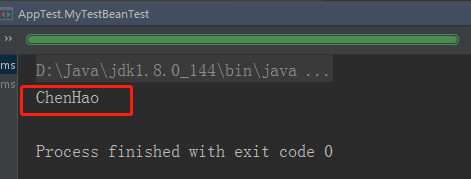
其实直接使用BeanFactory作为容器对于Spring的使用并不多见,因为企业级应用项目中大多会使用的是ApplicationContext(后面我们会讲两者的区别,这里只是测试)
功能分析
接下来我们分析2中代码完成的功能;
- 读取配置文件spring-config.xml。
- 根据spring-config.xml中的配置找到对应的类的配置,并实例化。
- 调用实例化后的实例
下图是一个最简单spring功能架构,如果想完成我们预想的功能,至少需要3个类:
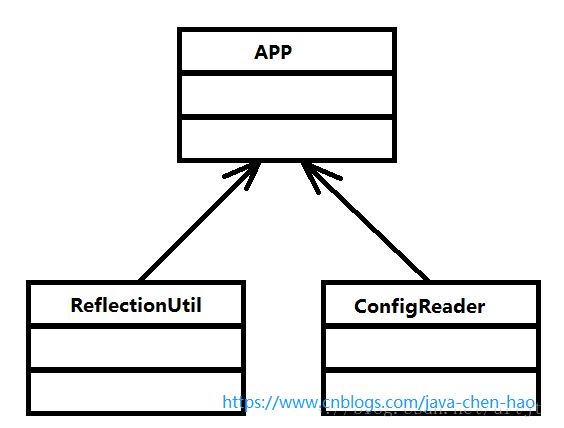
ConfigReader :用于读取及验证自己直文件 我们妥用配直文件里面的东西,当然首先 要做的就是读取,然后放直在内存中.
ReflectionUtil :用于根据配置文件中的自己直进行反射实例化,比如在上例中 spring-config.xml 出现的
App :用于完成整个逻辑的串联。
工程搭建
spring的源码中用于实现上面功能的是spring-bean这个工程,所以我们接下来看这个工程,当然spring-core是必须的。
beans包的层级结构
阅读源码最好的方式是跟着示例操作一遍,我们先看看beans工程的源码结构,如下图所示:
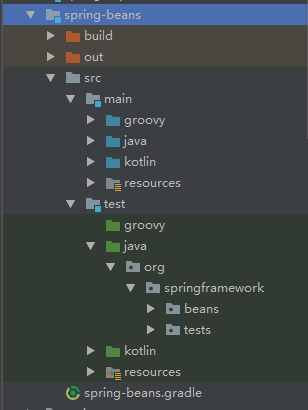
- src/main/java 用于展现Spring的主要逻辑
- src/main/resources 用于存放系统的配置文件
- src/test/java 用于对主要逻辑进行单元测试
- src/test/resources 用于存放测试用的配置文件
核心类介绍
接下来我们先了解下spring-bean最核心的两个类:DefaultListableBeanFactory和XmlBeanDefinitionReader
DefaultListableBeanFactory
XmlBeanFactory继承自DefaultListableBeanFactory,而DefaultListableBeanFactory是整个bean加载的核心部分,是Spring注册及加载bean的默认实现,而对于XmlBeanFactory与DefaultListableBeanFactory不同的地方其实是在XmlBeanFactory中使用了自定义的XML读取器XmlBeanDefinitionReader,实现了个性化的BeanDefinitionReader读取,DefaultListableBeanFactory继承了AbstractAutowireCapableBeanFactory并实现了ConfigurableListableBeanFactory以及BeanDefinitionRegistry接口。以下是ConfigurableListableBeanFactory的层次结构图以下相关类图
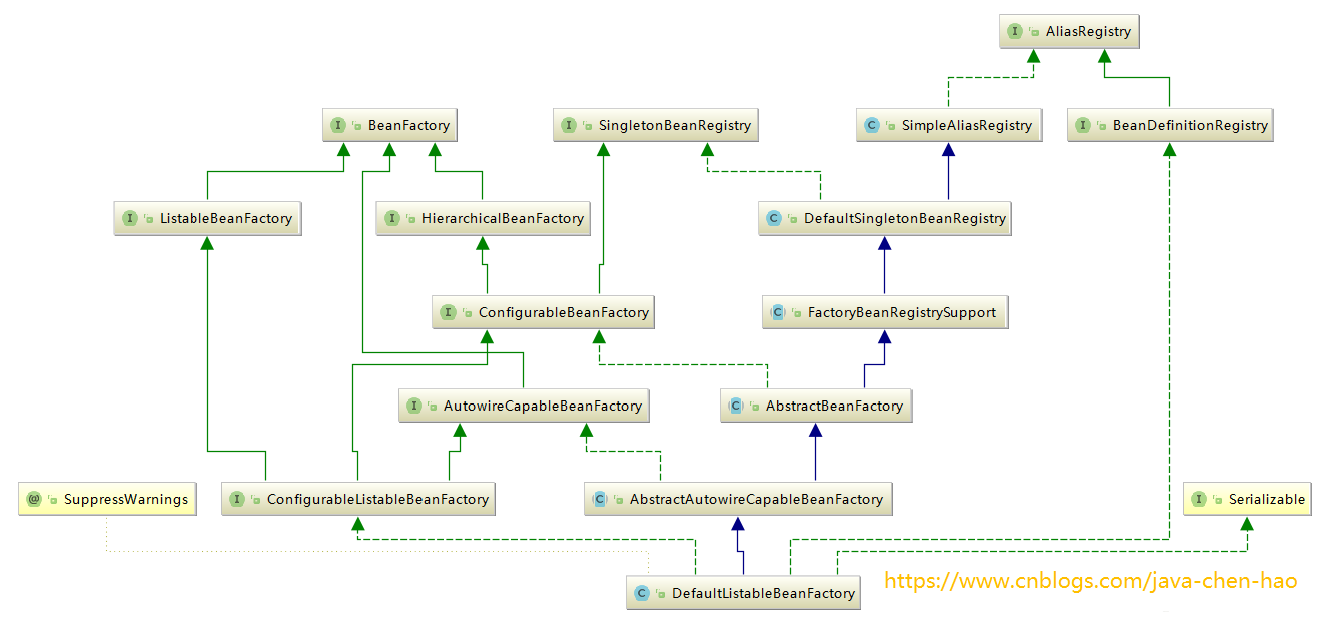
上面类图中各个类及接口的作用如下:
- AliasRegistry:定义对alias的简单增删改等操作
- SimpleAliasRegistry:主要使用map作为alias的缓存,并对接口AliasRegistry进行实现
- SingletonBeanRegistry:定义对单例的注册及获取
- BeanFactory:定义获取bean及bean的各种属性
- DefaultSingletonBeanRegistry:默认对接口SingletonBeanRegistry各函数的实现
- HierarchicalBeanFactory:继承BeanFactory,也就是在BeanFactory定义的功能的基础上增加了对parentFactory的支持
- BeanDefinitionRegistry:定义对BeanDefinition的各种增删改操作
- FactoryBeanRegistrySupport:在DefaultSingletonBeanRegistry基础上增加了对FactoryBean的特殊处理功能
- ConfigurableBeanFactory:提供配置Factory的各种方法
- ListableBeanFactory:根据各种条件获取bean的配置清单
- AbstractBeanFactory:综合FactoryBeanRegistrySupport和ConfigurationBeanFactory的功能
- AutowireCapableBeanFactory:提供创建bean、自动注入、初始化以及应用bean的后处理器
- AbstractAutowireCapableBeanFactory:综合AbstractBeanFactory并对接口AutowireCapableBeanFactory进行实现
- ConfigurableListableBeanFactory:BeanFactory配置清单,指定忽略类型及接口等
- DefaultListableBeanFactory:综合上面所有功能,主要是对Bean注册后的处理
XmlBeanFactory对DefaultListableBeanFactory类进行了扩展,主要用于从XML文档中读取BeanDefinition,对于注册及获取Bean都是使用从父类DefaultListableBeanFactory继承的方法去实现,而唯独与父类不同的个性化实现就是增加了XmlBeanDefinitionReader类型的reader属性。在XmlBeanFactory中主要使用reader属性对资源文件进行读取和注册
XmlBeanDefinitionReader
XML配置文件的读取是Spring中重要的功能,因为Spring的大部分功能都是以配置作为切入点的,可以从XmlBeanDefinitionReader中梳理一下资源文件读取、解析及注册的大致脉络,首先看看各个类的功能
ResourceLoader:定义资源加载器,主要应用于根据给定的资源文件地址返回对应的Resource
BeanDefinitionReader:主要定义资源文件读取并转换为BeanDefinition的各个功能
EnvironmentCapable:定义获取Environment方法
DocumentLoader:定义从资源文件加载到转换为Document的功能
AbstractBeanDefinitionReader:对EnvironmentCapable、BeanDefinitionReader类定义的功能进行实现
BeanDefinitionDocumentReader:定义读取Document并注册BeanDefinition功能
BeanDefinitionParserDelegate:定义解析Element的各种方法
整个XML配置文件读取的大致流程,在XmlBeanDefinitionReader中主要包含以下几步处理
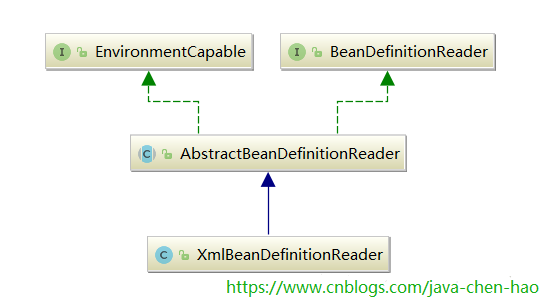
(1)通过继承自AbstractBeanDefinitionReader中的方法,来使用ResourceLoader将资源文件路径转换为对应的Resource文件
(2)通过DocumentLoader对Resource文件进行转换,将Resource文件转换为Document文件
(3)通过实现接口BeanDefinitionDocumentReader的DefaultBeanDefinitionDocumentReader类对Document进行解析,并使用BeanDefinitionParserDelegate对Element进行解析
容器的基础XmlBeanFactory
通过上面的内容我们对spring的容器已经有了大致的了解,接下来我们详细探索每个步骤的详细实现,接下来要分析的功能都是基于如下代码:
BeanFactory bf = new XmlBeanFactory( new ClassPathResource("spring-config.xml"));首先调用ClassPathResource的构造函数来构造Resource资源文件的实例对象,这样后续的资源处理就可以用Resource提供的各种服务来操作了。有了Resource后就可以对BeanFactory进行初始化操作,那配置文件是如何封装的呢?
配置文件的封装
Spring的配置文件读取是通过ClassPathResource进行封装的,Spring对其内部使用到的资源实现了自己的抽象结构:Resource接口来封装底层资源,如下源码:
public interface InputStreamSource { InputStream getInputStream() throws IOException;
}
public interface Resource extends InputStreamSource {
boolean exists();
default boolean isReadable() {
return true;
}
default boolean isOpen() {
return false;
}
default boolean isFile() {
return false;
}
URL getURL() throws IOException;
URI getURI() throws IOException;
File getFile() throws IOException;
default ReadableByteChannel readableChannel() throws IOException {
return Channels.newChannel(getInputStream());
}
long contentLength() throws IOException;
long lastModified() throws IOException;
Resource createRelative(String relativePath) throws IOException;
String getFilename();
String getDescription();
}
InputStreamSource封装任何能返回InputStream的类,比如File、Classpath下的资源和Byte Array等, 它只有一个方法定义:getInputStream(),该方法返回一个新的InputStream对象 。
Resource接口抽象了所有Spring内部使用到的底层资源:File、URL、Classpath等。首先,它定义了3个判断当前资源状态的方法:存在性(exists)、可读性(isReadable)、是否处于打开状态(isOpen)。另外,Resource接口还提供了不同资源到URL、URI、File类型的转换,以及获取lastModified属性、文件名(不带路径信息的文件名,getFilename())的方法,为了便于操作,Resource还提供了基于当前资源创建一个相对资源的方法:createRelative(),还提供了getDescription()方法用于在错误处理中的打印信息。
对不同来源的资源文件都有相应的Resource实现:文件(FileSystemResource)、Classpath资源(ClassPathResource)、URL资源(UrlResource)、InputStream资源(InputStreamResource)、Byte数组(ByteArrayResource)等,相关类图如下所示:
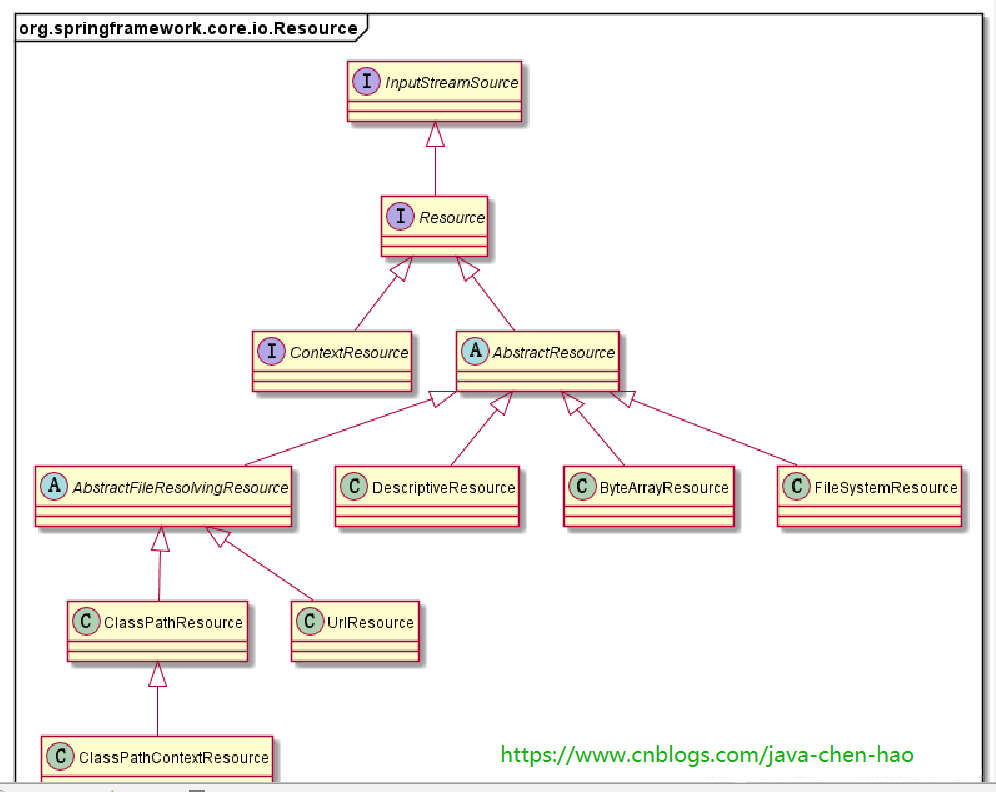
在日常开发中我们可以直接使用spring提供的类来加载资源文件,比如在希望加载资源文件时可以使用下面的代码:
Resource resource = new ClassPathResource("spring-config.xml");InputStream is = resource.getInputStream();
有了 Resource 接口便可以对所有资源文件进行统一处理 至于实现,其实是非常简单的,以 getlnputStream 为例,ClassPathResource 中的实现方式便是通 class 或者 classLoader 提供的底层方法进行调用,而对于 FileSystemResource 其实更简单,直接使用 FileInputStream 对文件进行实例化。
ClassPathResource.java
InputStream is;if (this.clazz != null) {
is = this.clazz.getResourceAsStream(this.path);
}
else if (this.classLoader != null) {
is = this.classLoader.getResourceAsStream(this.path);
}
else {
is = ClassLoader.getSystemResourceAsStream(this.path);
}
FileSystemResource.java
public InputStream getinputStream () throws IOException { return new FilelnputStream(this file) ;
}
当通过Resource相关类完成了对配置文件进行封装后,配置文件的读取工作就全权交给XmlBeanDefinitionReader来处理了。
接下来就进入到XmlBeanFactory的初始化过程了,XmlBeanFactory的初始化有若干办法,Spring提供了很多的构造函数,在这里分析的是使用Resource实例作为构造函数参数的办法,代码如下:
XmlBeanFactory.java
public XmlBeanFactory(Resource resource) throws BeansException { this(resource, null);
}
public XmlBeanFactory(Resource resource, BeanFactory parentBeanFactory) throws BeansException {
super(parentBeanFactory);
this.reader.loadBeanDefinitions(resource);
}
上面函数中的代码this.reader.loadBeanDefinitions(resource)才是资源加载的真正实现,但是在XmlBeanDefinitionReader加载数据前还有一个调用父类构造函数初始化的过程:super(parentBeanFactory),我们按照代码层级进行跟踪,首先跟踪到如下父类代码:
public DefaultListableBeanFactory(@Nullable BeanFactory parentBeanFactory) { super(parentBeanFactory);
}
然后继续跟踪,跟踪代码到父类AbstractAutowireCapableBeanFactory的构造函数中:
public AbstractAutowireCapableBeanFactory(@Nullable BeanFactory parentBeanFactory) { this();
setParentBeanFactory(parentBeanFactory);
}
public AbstractAutowireCapableBeanFactory() {
super();
ignoreDependencyInterface(BeanNameAware.class);
ignoreDependencyInterface(BeanFactoryAware.class);
ignoreDependencyInterface(BeanClassLoaderAware.class);
}
这里有必要提及 ignoreDependencylnterface方法,ignoreDependencylnterface 的主要功能是 忽略给定接口的向动装配功能,那么,这样做的目的是什么呢?会产生什么样的效果呢?
举例来说,当 A 中有属性 B ,那么当 Spring 在获取 A的 Bean 的时候如果其属性 B 还没有 初始化,那么 Spring 会自动初始化 B,这也是 Spring 提供的一个重要特性 。但是,某些情况 下, B不会被初始化,其中的一种情况就是B 实现了 BeanNameAware 接口 。Spring 中是这样介绍的:自动装配时忽略给定的依赖接口,典型应用是边过其他方式解析 Application 上下文注册依赖,类似于 BeanFactor 通过 BeanFactoryAware 进行注入或者 ApplicationContext 通过 ApplicationContextAware 进行注入。
调用ignoreDependencyInterface方法后,被忽略的接口会存储在BeanFactory的名为ignoredDependencyInterfaces的Set集合中:
public abstract class AbstractAutowireCapableBeanFactory extends AbstractBeanFactory implements AutowireCapableBeanFactory {
private final Set<Class<?>> ignoredDependencyInterfaces = new HashSet<>();
public void ignoreDependencyInterface(Class<?> ifc) {
this.ignoredDependencyInterfaces.add(ifc);
}
...
}
ignoredDependencyInterfaces集合在同类中被使用仅在一处——isExcludedFromDependencyCheck方法中:
protected boolean isExcludedFromDependencyCheck(PropertyDescriptor pd) { return (AutowireUtils.isExcludedFromDependencyCheck(pd) || this.ignoredDependencyTypes.contains(pd.getPropertyType()) || AutowireUtils.isSetterDefinedInInterface(pd, this.ignoredDependencyInterfaces));
}
而ignoredDependencyInterface的真正作用还得看AutowireUtils类的isSetterDefinedInInterface方法。
public static boolean isSetterDefinedInInterface(PropertyDescriptor pd, Set<Class<?>> interfaces) { //获取bean中某个属性对象在bean类中的setter方法
Method setter = pd.getWriteMethod();
if (setter != null) {
// 获取bean的类型
Class<?> targetClass = setter.getDeclaringClass();
for (Class<?> ifc : interfaces) {
if (ifc.isAssignableFrom(targetClass) && // bean类型是否接口的实现类
ClassUtils.hasMethod(ifc, setter.getName(), setter.getParameterTypes())) { // 接口是否有入参和bean类型完全相同的setter方法
return true;
}
}
}
return false;
}
ignoredDependencyInterface方法并不是让我们在自动装配时直接忽略实现了该接口的依赖。这个方法的真正意思是忽略该接口的实现类中和接口setter方法入参类型相同的依赖。
举个例子。首先定义一个要被忽略的接口。
public interface IgnoreInterface { void setList(List<String> list);
void setSet(Set<String> set);
}
然后需要实现该接口,在实现类中注意要有setter方法入参相同类型的域对象,在例子中就是List
public class IgnoreInterfaceImpl implements IgnoreInterface { private List<String> list;
private Set<String> set;
@Override
public void setList(List<String> list) {
this.list = list;
}
@Override
public void setSet(Set<String> set) {
this.set = set;
}
public List<String> getList() {
return list;
}
public Set<String> getSet() {
return set;
}
}
定义xml配置文件:
<?xml version="1.0" encoding="UTF-8"?><beans xmlns="http://www.springframework.org/schema/beans"
xmlns:xsi="http://www.w3.org/2001/XMLSchema-instance"
xmlns:context="http://www.springframework.org/schema/context"
xsi:schemaLocation="http://www.springframework.org/schema/beans
http://www.springframework.org/schema/beans/spring-beans.xsd
http://www.springframework.org/schema/context
http://www.springframework.org/schema/context/spring-context.xsd"
default-autowire="byType">
<bean id="list" class="java.util.ArrayList">
<constructor-arg>
<list>
<value>foo</value>
<value>bar</value>
</list>
</constructor-arg>
</bean>
<bean id="set" class="java.util.HashSet">
<constructor-arg>
<list>
<value>foo</value>
<value>bar</value>
</list>
</constructor-arg>
</bean>
<bean id="ii" class="com.chenhao.ignoreDependency.IgnoreInterfaceImpl"/>
<bean class="com.chenhao.autowire.IgnoreAutowiringProcessor"/>
</beans>
最后调用ignoreDependencyInterface:
beanFactory.ignoreDependencyInterface(IgnoreInterface.class);运行结果:
null
null
而如果不调用ignoreDependencyInterface,则是:
[foo, bar]
[bar, foo]
我们最初理解是在自动装配时忽略该接口的实现,实际上是在自动装配时忽略该接口实现类中和setter方法入参相同的类型,也就是忽略该接口实现类中存在依赖外部的bean属性注入。
典型应用就是BeanFactoryAware和ApplicationContextAware接口。
首先看该两个接口的源码:
public interface BeanFactoryAware extends Aware { void setBeanFactory(BeanFactory beanFactory) throws BeansException;
}
public interface ApplicationContextAware extends Aware {
void setApplicationContext(ApplicationContext applicationContext) throws BeansException;
}
在Spring源码中在不同的地方忽略了该两个接口:
beanFactory.ignoreDependencyInterface(ApplicationContextAware.class);ignoreDependencyInterface(BeanFactoryAware.class);
使得我们的BeanFactoryAware接口实现类在自动装配时不能被注入BeanFactory对象的依赖:
public class MyBeanFactoryAware implements BeanFactoryAware { private BeanFactory beanFactory; // 自动装配时忽略注入
@Override
public void setBeanFactory(BeanFactory beanFactory) throws BeansException {
this.beanFactory = beanFactory;
}
public BeanFactory getBeanFactory() {
return beanFactory;
}
}
ApplicationContextAware接口实现类中的ApplicationContext对象的依赖同理:
public class MyApplicationContextAware implements ApplicationContextAware { private ApplicationContext applicationContext; // 自动装配时被忽略注入
@Override
public void setApplicationContext(ApplicationContext applicationContext) throws BeansException {
this.applicationContext = applicationContext;
}
public ApplicationContext getApplicationContext() {
return applicationContext;
}
}
这样的做法使得ApplicationContextAware和BeanFactoryAware中的ApplicationContext或BeanFactory依赖在自动装配时被忽略,而统一由框架设置依赖,如ApplicationContextAware接口的设置会在ApplicationContextAwareProcessor类中完成:
private void invokeAwareInterfaces(Object bean) { if (bean instanceof Aware) {
if (bean instanceof EnvironmentAware) {
((EnvironmentAware) bean).setEnvironment(this.applicationContext.getEnvironment());
}
if (bean instanceof EmbeddedValueResolverAware) {
((EmbeddedValueResolverAware) bean).setEmbeddedValueResolver(this.embeddedValueResolver);
}
if (bean instanceof ResourceLoaderAware) {
((ResourceLoaderAware) bean).setResourceLoader(this.applicationContext);
}
if (bean instanceof ApplicationEventPublisherAware) {
((ApplicationEventPublisherAware) bean).setApplicationEventPublisher(this.applicationContext);
}
if (bean instanceof MessageSourceAware) {
((MessageSourceAware) bean).setMessageSource(this.applicationContext);
}
if (bean instanceof ApplicationContextAware) {
((ApplicationContextAware) bean).setApplicationContext(this.applicationContext);
}
}
}
通过这种方式保证了ApplicationContextAware和BeanFactoryAware中的容器保证是生成该bean的容器。
bean加载
在之前XmlBeanFactory构造函数中调用了XmlBeanDefinitionReader类型的reader属性提供的方法this.reader.loadBeanDefinitions(resource),而这句代码则是整个资源加载的切入点,这个方法的时序图如下:
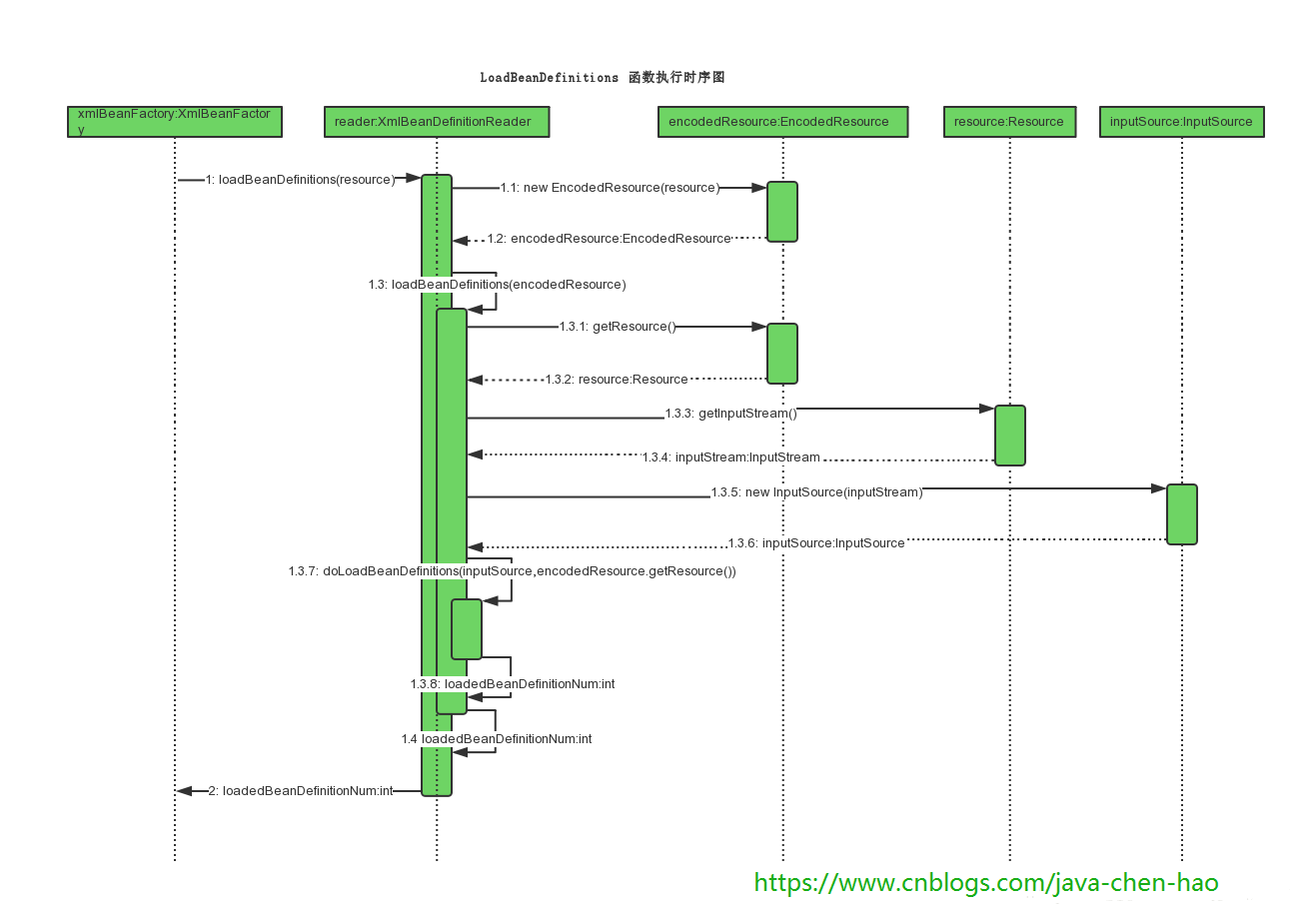
我们来梳理下上述时序图的处理过程:
(1)封装资源文件。当进入XmlBeanDefinitionReader后首先对参数Resource使用EncodedResource类进行封装
(2)获取输入流。从Resource中获取对应的InputStream并构造InputSource
(3)通过构造的InputSource实例和Resource实例继续调用函数doLoadBeanDefinitions,loadBeanDefinitions函数具体的实现过程:
public int loadBeanDefinitions(EncodedResource encodedResource) throws BeanDefinitionStoreException { Assert.notNull(encodedResource, "EncodedResource must not be null");
if (logger.isTraceEnabled()) {
logger.trace("Loading XML bean definitions from " + encodedResource);
}
Set<EncodedResource> currentResources = this.resourcesCurrentlyBeingLoaded.get();
if (currentResources == null) {
currentResources = new HashSet<>(4);
this.resourcesCurrentlyBeingLoaded.set(currentResources);
}
if (!currentResources.add(encodedResource)) {
throw new BeanDefinitionStoreException(
"Detected cyclic loading of " + encodedResource + " - check your import definitions!");
}
try {
InputStream inputStream = encodedResource.getResource().getInputStream();
try {
InputSource inputSource = new InputSource(inputStream);
if (encodedResource.getEncoding() != null) {
inputSource.setEncoding(encodedResource.getEncoding());
}
return doLoadBeanDefinitions(inputSource, encodedResource.getResource());
}
finally {
inputStream.close();
}
}
...
}
EncodedResource的作用是对资源文件的编码进行处理的,其中的主要逻辑体现在getReader()方法中,当设置了编码属性的时候Spring会使用相应的编码作为输入流的编码,在构造好了encodeResource对象后,再次转入了可复用方法loadBeanDefinitions(new EncodedResource(resource)),这个方法内部才是真正的数据准备阶段,代码如下:
protected int doLoadBeanDefinitions(InputSource inputSource, Resource resource) throws BeanDefinitionStoreException {
try {
// 获取 Document 实例
Document doc = doLoadDocument(inputSource, resource);
// 根据 Document 实例****注册 Bean信息
return registerBeanDefinitions(doc, resource);
}
...
}
核心部分就是 try 块的两行代码。
- 调用
doLoadDocument()方法,根据 xml 文件获取 Document 实例。 - 根据获取的 Document 实例注册 Bean 信息
其实在doLoadDocument()方法内部还获取了 xml 文件的验证模式。如下:
protected Document doLoadDocument(InputSource inputSource, Resource resource) throws Exception { return this.documentLoader.loadDocument(inputSource, getEntityResolver(), this.errorHandler,
getValidationModeForResource(resource), isNamespaceAware());
}
调用 getValidationModeForResource() 获取指定资源(xml)的验证模式。所以 doLoadBeanDefinitions()主要就是做了三件事情。
- 调用
getValidationModeForResource()获取 xml 文件的验证模式 - 调用
loadDocument()根据 xml 文件获取相应的 Document 实例。 - 调用
registerBeanDefinitions()注册 Bean 实例。
获取XML的验证模式
DTD和XSD区别
DTD(Document Type Definition)即文档类型定义,是一种XML约束模式语言,是XML文件的验证机制,属于XML文件组成的一部分。DTD是一种保证XML文档格式正确的有效方法,可以通过比较XML文档和DTD文件来看文档是否符合规范,元素和标签使用是否正确。一个DTD文档包含:元素的定义规则,元素间关系的定义规则,元素可使用的属性,可使用的实体或符合规则。
使用DTD验证模式的时候需要在XML文件的头部声明,以下是在Spring中使用DTD声明方式的代码:
<?xml version="1.0" encoding="UTF-8"?><!DOCTYPE beans PUBLIC "-//Spring//DTD BEAN 2.0//EN" "http://www.Springframework.org/dtd/Spring-beans-2.0.dtd">
XML Schema语言就是XSD(XML Schemas Definition)。XML Schema描述了XML文档的结构,可以用一个指定的XML Schema来验证某个XML文档,以检查该XML文档是否符合其要求,文档设计者可以通过XML Schema指定一个XML文档所允许的结构和内容,并可据此检查一个XML文档是否是有效的。
在使用XML Schema文档对XML实例文档进行检验,除了要声明名称空间外(xmlns=http://www.Springframework.org/schema/beans),还必须指定该名称空间所对应的XML Schema文档的存储位置,通过schemaLocation属性来指定名称空间所对应的XML Schema文档的存储位置,它包含两个部分,一部分是名称空间的URI,另一部分就该名称空间所标识的XML Schema文件位置或URL地址(xsi:schemaLocation=”http://www.Springframework.org/schema/beans http://www.Springframework.org/schema/beans/Spring-beans.xsd“),代码如下:
<?xml version="1.0" encoding="UTF-8"?><beans xmlns="http://www.springframework.org/schema/beans"
xmlns:xsi="http://www.w3.org/2001/XMLSchema-instance"
xsi:schemaLocation="http://www.springframework.org/schema/beans http://www.springframework.org/schema/beans/spring-beans.xsd">
<bean id="myTestBean" class="com.chenhao.spring.MyTestBean"/>
</beans>
验证模式的读取
在spring中,是通过getValidationModeForResource方法来获取对应资源的验证模式,其源码如下:
protected int getValidationModeForResource(Resource resource) { int validationModeToUse = getValidationMode();
if (validationModeToUse != VALIDATION_AUTO) {
return validationModeToUse;
}
int detectedMode = detectValidationMode(resource);
if (detectedMode != VALIDATION_AUTO) {
return detectedMode;
}
// Hmm, we didn't get a clear indication... Let's assume XSD,
// since apparently no DTD declaration has been found up until
// detection stopped (before finding the document's root tag).
return VALIDATION_XSD;
}
方法的实现还是很简单的,如果设定了验证模式则使用设定的验证模式(可以通过使用XmlBeanDefinitionReader中的setValidationMode方法进行设定),否则使用自动检测的方式。而自动检测验证模式的功能是在函数detectValidationMode方法中,而在此方法中又将自动检测验证模式的工作委托给了专门处理类XmlValidationModeDetector的validationModeDetector方法,具体代码如下:
public int detectValidationMode(InputStream inputStream) throws IOException { // Peek into the file to look for DOCTYPE.
BufferedReader reader = new BufferedReader(new InputStreamReader(inputStream));
try {
boolean isDtdValidated = false;
String content;
while ((content = reader.readLine()) != null) {
content = consumeCommentTokens(content);
if (this.inComment || !StringUtils.hasText(content)) {
continue;
}
if (hasDoctype(content)) {
isDtdValidated = true;
break;
}
if (hasOpeningTag(content)) {
// End of meaningful data...
break;
}
}
return (isDtdValidated ? VALIDATION_DTD : VALIDATION_XSD);
}
catch (CharConversionException ex) {
// Choked on some character encoding...
// Leave the decision up to the caller.
return VALIDATION_AUTO;
}
finally {
reader.close();
}
}
从代码中看,主要是通过读取 XML 文件的内容,判断内容中是否包含有 DOCTYPE ,如果是 则为 DTD,否则为 XSD,当然只会读取到 第一个 “<” 处,因为 验证模式一定会在第一个 “<” 之前。如果当中出现了 CharConversionException 异常,则为 XSD模式。
获取Document
经过了验证模式准备的步骤就可以进行Document加载了,对于文档的读取委托给了DocumentLoader去执行,这里的DocumentLoader是个接口,而真正调用的是DefaultDocumentLoader,解析代码如下:
public Document loadDocument(InputSource inputSource, EntityResolver entityResolver, ErrorHandler errorHandler, int validationMode, boolean namespaceAware) throws Exception {
DocumentBuilderFactory factory = createDocumentBuilderFactory(validationMode, namespaceAware);
if (logger.isDebugEnabled()) {
logger.debug("Using JAXP provider [" + factory.getClass().getName() + "]");
}
DocumentBuilder builder = createDocumentBuilder(factory, entityResolver, errorHandler);
return builder.parse(inputSource);
}
分析代码,首选创建DocumentBuildFactory,再通过DocumentBuilderFactory创建DocumentBuilder,进而解析InputSource来返回Document对象。对于参数entityResolver,传入的是通过getEntityResolver()函数获取的返回值,代码如下:
protected EntityResolver getEntityResolver() { if (this.entityResolver == null) {
// Determine default EntityResolver to use.
ResourceLoader resourceLoader = getResourceLoader();
if (resourceLoader != null) {
this.entityResolver = new ResourceEntityResolver(resourceLoader);
}
else {
this.entityResolver = new DelegatingEntityResolver(getBeanClassLoader());
}
}
return this.entityResolver;
}
这个entityResolver是做什么用的呢,接下来我们详细分析下。
EntityResolver 的用法
对于解析一个XML,SAX首先读取该XML文档上的声明,根据声明去寻找相应的DTD定义,以便对文档进行一个验证,默认的寻找规则,即通过网络(实现上就是声明DTD的URI地址)来下载相应的DTD声明,并进行认证。下载的过程是一个漫长的过程,而且当网络中断或不可用时,这里会报错,就是因为相应的DTD声明没有被找到的原因.
EntityResolver的作用是项目本身就可以提供一个如何寻找DTD声明的方法,即由程序来实现寻找DTD声明的过程,比如将DTD文件放到项目中某处,在实现时直接将此文档读取并返回给SAX即可,在EntityResolver的接口只有一个方法声明:
public abstract InputSource resolveEntity (String publicId, String systemId) throws SAXException, IOException;
它接收两个参数publicId和systemId,并返回一个InputSource对象,以特定配置文件来进行讲解
(1)如果在解析验证模式为XSD的配置文件,代码如下:
<?xml version="1.0" encoding="UTF-8"?><beans xmlns="http://www.Springframework.org/schema/beans"
xmlns:xsi="http://www.w3.org/2001/XMLSchema-instance"
xsi:schemaLocation="http://www.Springframework.org/schema/beans http://www.Springframework.org/schema/beans/Spring-beans.xsd">
....
</beans>
则会读取到以下两个参数
- publicId:null
- systemId:http://www.Springframework.org/schema/beans/Spring-beans.xsd

(2)如果解析验证模式为DTD的配置文件,代码如下:
<?xml version="1.0" encoding="UTF-8"?><!DOCTYPE beans PUBLIC "-//Spring//DTD BEAN 2.0//EN" "http://www.Springframework.org/dtd/Spring-beans-2.0.dtd">
....
</beans>
读取到以下两个参数
- publicId:-//Spring//DTD BEAN 2.0//EN
- systemId:http://www.Springframework.org/dtd/Spring-beans-2.0.dtd

一般都会把验证文件放置在自己的工程里,如果把URL转换为自己工程里对应的地址文件呢?以加载DTD文件为例来看看Spring是如何实现的。根据之前Spring中通过getEntityResolver()方法对EntityResolver的获取,我们知道,Spring中使用DelegatingEntityResolver类为EntityResolver的实现类,resolveEntity实现方法如下:
@Override@Nullable
public InputSource resolveEntity(String publicId, @Nullable String systemId) throws SAXException, IOException {
if (systemId != null) {
if (systemId.endsWith(DTD_SUFFIX)) {
return this.dtdResolver.resolveEntity(publicId, systemId);
}
else if (systemId.endsWith(XSD_SUFFIX)) {
return this.schemaResolver.resolveEntity(publicId, systemId);
}
}
return null;
}
不同的验证模式使用不同的解析器解析,比如加载DTD类型的BeansDtdResolver的resolveEntity是直接截取systemId最后的xx.dtd然后去当前路径下寻找,而加载XSD类型的PluggableSchemaResolver类的resolveEntity是默认到META-INF/Spring.schemas文件中找到systemId所对应的XSD文件并加载。 BeansDtdResolver 的解析过程如下:
public InputSource resolveEntity(String publicId, @Nullable String systemId) throws IOException { if (logger.isTraceEnabled()) {
logger.trace("Trying to resolve XML entity with public ID [" + publicId +
"] and system ID [" + systemId + "]");
}
if (systemId != null && systemId.endsWith(DTD_EXTENSION)) {
int lastPathSeparator = systemId.lastIndexOf('/');
int dtdNameStart = systemId.indexOf(DTD_NAME, lastPathSeparator);
if (dtdNameStart != -1) {
String dtdFile = DTD_NAME + DTD_EXTENSION;
if (logger.isTraceEnabled()) {
logger.trace("Trying to locate [" + dtdFile + "] in Spring jar on classpath");
}
try {
Resource resource = new ClassPathResource(dtdFile, getClass());
InputSource source = new InputSource(resource.getInputStream());
source.setPublicId(publicId);
source.setSystemId(systemId);
if (logger.isDebugEnabled()) {
logger.debug("Found beans DTD [" + systemId + "] in classpath: " + dtdFile);
}
return source;
}
catch (IOException ex) {
if (logger.isDebugEnabled()) {
logger.debug("Could not resolve beans DTD [" + systemId + "]: not found in classpath", ex);
}
}
}
}
return null;
}
从上面的代码中我们可以看到加载 DTD 类型的 BeansDtdResolver.resolveEntity() 只是对 systemId 进行了简单的校验(从最后一个 / 开始,内容中是否包含 spring-beans),然后构造一个 InputSource 并设置 publicId、systemId,然后返回。 PluggableSchemaResolver 的解析过程如下:
public InputSource resolveEntity(String publicId, @Nullable String systemId) throws IOException { if (logger.isTraceEnabled()) {
logger.trace("Trying to resolve XML entity with public id [" + publicId +
"] and system id [" + systemId + "]");
}
if (systemId != null) {
String resourceLocation = getSchemaMappings().get(systemId);
if (resourceLocation != null) {
Resource resource = new ClassPathResource(resourceLocation, this.classLoader);
try {
InputSource source = new InputSource(resource.getInputStream());
source.setPublicId(publicId);
source.setSystemId(systemId);
if (logger.isDebugEnabled()) {
logger.debug("Found XML schema [" + systemId + "] in classpath: " + resourceLocation);
}
return source;
}
catch (FileNotFoundException ex) {
if (logger.isDebugEnabled()) {
logger.debug("Couldn't find XML schema [" + systemId + "]: " + resource, ex);
}
}
}
}
return null;
}
首先调用 getSchemaMappings() 获取一个映射表(systemId 与其在本地的对照关系),然后根据传入的 systemId 获取该 systemId 在本地的路径 resourceLocation,最后根据 resourceLocation 构造 InputSource 对象。 映射表如下(部分):
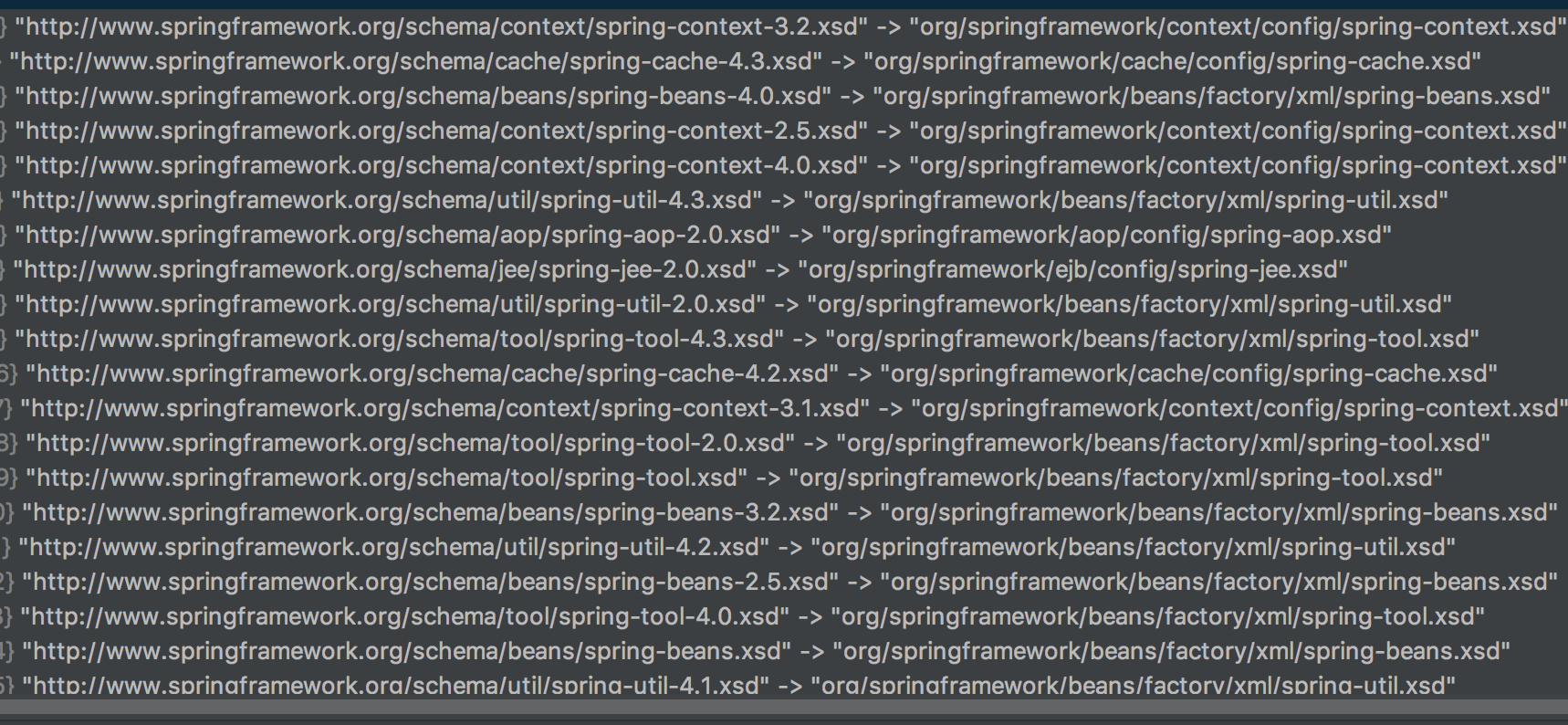
解析及注册BeanDefinitions
当把文件转换成Document后,接下来就是对bean的提取及注册,当程序已经拥有了XML文档文件的Document实例对象时,就会被引入到XmlBeanDefinitionReader.registerBeanDefinitions这个方法:
public int registerBeanDefinitions(Document doc, Resource resource) throws BeanDefinitionStoreException { BeanDefinitionDocumentReader documentReader = createBeanDefinitionDocumentReader();
int countBefore = getRegistry().getBeanDefinitionCount();
documentReader.registerBeanDefinitions(doc, createReaderContext(resource));
return getRegistry().getBeanDefinitionCount() - countBefore;
}
其中的doc参数即为上节读取的document,而BeanDefinitionDocumentReader是一个接口,而实例化的工作是在createBeanDefinitionDocumentReader()中完成的,而通过此方法,BeanDefinitionDocumentReader真正的类型其实已经是DefaultBeanDefinitionDocumentReader了,进入DefaultBeanDefinitionDocumentReader后,发现这个方法的重要目的之一就是提取root,以便于再次将root作为参数继续BeanDefinition的注册,如下代码:
public void registerBeanDefinitions(Document doc, XmlReaderContext readerContext) { this.readerContext = readerContext;
logger.debug("Loading bean definitions");
Element root = doc.getDocumentElement();
doRegisterBeanDefinitions(root);
}
通过这里我们看到终于到了解析逻辑的核心方法doRegisterBeanDefinitions,接着跟踪源码如下:
protected void doRegisterBeanDefinitions(Element root) { BeanDefinitionParserDelegate parent = this.delegate;
this.delegate = createDelegate(getReaderContext(), root, parent);
if (this.delegate.isDefaultNamespace(root)) {
String profileSpec = root.getAttribute(PROFILE_ATTRIBUTE);
if (StringUtils.hasText(profileSpec)) {
String[] specifiedProfiles = StringUtils.tokenizeToStringArray(
profileSpec, BeanDefinitionParserDelegate.MULTI_VALUE_ATTRIBUTE_DELIMITERS);
if (!getReaderContext().getEnvironment().acceptsProfiles(specifiedProfiles)) {
if (logger.isInfoEnabled()) {
logger.info("Skipped XML bean definition file due to specified profiles [" + profileSpec +
"] not matching: " + getReaderContext().getResource());
}
return;
}
}
}
preProcessXml(root);
parseBeanDefinitions(root, this.delegate);
postProcessXml(root);
this.delegate = parent;
}
我们看到首先要解析profile属性,然后才开始XML的读取,具体的代码如下:
protected void parseBeanDefinitions(Element root, BeanDefinitionParserDelegate delegate) { if (delegate.isDefaultNamespace(root)) {
NodeList nl = root.getChildNodes();
for (int i = 0; i < nl.getLength(); i++) {
Node node = nl.item(i);
if (node instanceof Element) {
Element ele = (Element) node;
if (delegate.isDefaultNamespace(ele)) {
parseDefaultElement(ele, delegate);
}
else {
delegate.parseCustomElement(ele);
}
}
}
}
else {
delegate.parseCustomElement(root);
}
}
最终解析动作落地在两个方法处:parseDefaultElement(ele, delegate) 和 delegate.parseCustomElement(root)。我们知道在 Spring 有两种 Bean 声明方式:
- 配置文件式声明:
`` - 自定义注解方式:
<tx:annotation-driven>
两种方式的读取和解析都存在较大的差异,所以采用不同的解析方法,如果根节点或者子节点采用默认命名空间的话,则调用 parseDefaultElement() 进行解析,否则调用 delegate.parseCustomElement() 方法进行自定义解析。
而判断是否默认命名空间还是自定义命名空间的办法其实是使用node.getNamespaceURI()获取命名空间,并与Spring中固定的命名空间http://www.springframework.org/schema/beans进行对比,如果一致则认为是默认,否则就认为是自定义。
profile的用法
通过profile标记不同的环境,可以通过设置spring.profiles.active和spring.profiles.default激活指定profile环境。如果设置了active,default便失去了作用。如果两个都没有设置,那么带有profiles的bean都不会生成。
配置spring配置文件最下面配置如下beans
<!-- 开发环境配置文件 --><beans profile="development">
<context:property-placeholder
location="classpath*:config_common/*.properties, classpath*:config_development/*.properties"/>
</beans>
<!-- 测试环境配置文件 -->
<beans profile="test">
<context:property-placeholder
location="classpath*:config_common/*.properties, classpath*:config_test/*.properties"/>
</beans>
<!-- 生产环境配置文件 -->
<beans profile="production">
<context:property-placeholder
location="classpath*:config_common/*.properties, classpath*:config_production/*.properties"/>
</beans>
配置web.xml
<!-- 多环境配置 在上下文context-param中设置profile.default的默认值 --><context-param>
<param-name>spring.profiles.default</param-name>
<param-value>production</param-value>
</context-param>
<!-- 多环境配置 在上下文context-param中设置profile.active的默认值 -->
<!-- 设置active后default失效,web启动时会加载对应的环境信息 -->
<context-param>
<param-name>spring.profiles.active</param-name>
<param-value>test</param-value>
</context-param>
这样启动的时候就可以按照切换spring.profiles.active的属性值来进行切换了。
本文内容总结:概述,容器的基本用法,功能分析,工程搭建,beans包的层级结构,核心类介绍,容器的基础XmlBeanFactory,配置文件的封装,bean加载,获取XML的验证模式,获取Document,解析及注册BeanDefinitions,
原文链接:https://www.cnblogs.com/java-chen-hao/p/11113340.html
以上是 spring5 源码深度解析----- IOC 之 容器的基本实现 的全部内容, 来源链接: utcz.com/z/296145.html

